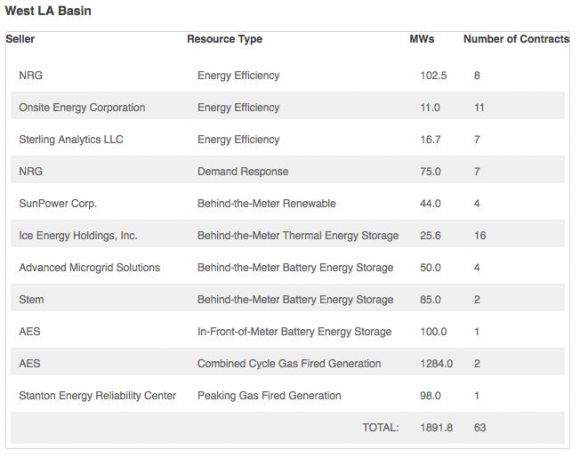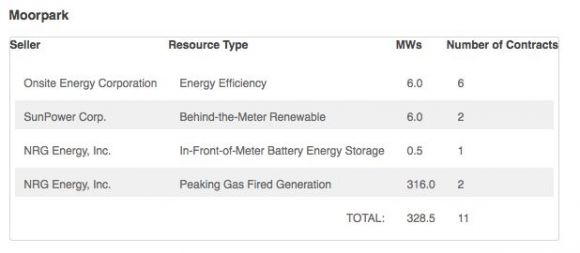The world's biggest battery is coming to California.
Last week, Southern California Edison (SCE) revealed the winners of a massive 250-megawatt energy storage procurement round, one that could set new standards for incorporating distributed and customer-owned energy assets into grid operations. The procurement represents a potential turning point for utilities.
GTM Research analyst Cory Honeyman commented, "Winning bids from the solicitation include a diverse array of grid-scale storage, behind-the-meter storage, distributed generation PV, thermal storage, demand response, energy efficiency, and natural gas peaker plants. While there have been broad procurement plans in the past, never before has a utility procured such a diverse cross-section of behind-the-meter and grid-scale solutions in one solicitation." Honeyman suggests, "This type of solicitation marks an emerging trend in utility procurement, where utilities move away from technology-specific and RPS-led procurement to a more unified approach in which solar PV, demand response, energy efficiency, and natural gas peakers compete in blended solicitations that are part of long-term procurement plans or integrated resource plans."
Overshadowed perhaps by an epochal change in the way utilities choose and deploy assets, however, was the news that Southern California Edison is procuring what might be the world's largest electrochemical battery (when it is deployed in a few years).
AES Energy Storage was selected to build a 100-megawatt “in-front-of-meter” battery system in SCE’s West Los Angeles Basin region, cementing its lead as the nation’s biggest grid-scale energy storage provider.
As we've reported, AES already manages the largest fleet of grid batteries in commercial service, with "more than 200 megawatts of storage resources in operation and construction, according to the firm. The company claims to have more than 1 gigawatt of energy storage in development across the globe. Parent company AES Corporation had revenue of $16 billion last year.
We spoke with John Zahurancik, president of AES Energy Storage.
He said, "It is truly a modernization of the power system -- the new state of the art," adding, "This contract marks the emergence of energy storage as a cost-effective alternative to peaking power plants for local power capacity and reliability."
A few facts and figures about the battery:
- It is 100 megawatts, able to provide 4 hours or 400 megawatt-hours of battery-based energy storage
- The resource must be completed by January 1, 2021
- The battery will be installed in one large building at the Alamitos Power Center in Long Beach, Calif.
- AES is providing services under a twenty-year power-purchase agreement
Zahurancik confirmed that, to the company's knowledge, this is the largest grid-scale electrochemical battery in development. DOE energy storage archives confirm this as well.
AES suggests that the energy storage resource "acts as both generation and load, enabling more than twice the flexible range of a traditional peaker plant on the same transmission infrastructure."
Zahurancik said, "It's the first time that energy storage has been included in all of the services for local capacity and given a fair playing field. It really is a transition to a new era -- with new technology providing new solutions with no emissions and no water use that are highly flexible. It helps us have an unbreakable grid." He added, "The storage we're delivering can do a lot more than balancing intermittency."
"We've been developing this approach over many years. We put the first lithium-ion system on the grid in 2008," he said. "We come from the power plant perspective -- trying to scale this technology," adding, "Energy storage can be smaller and modular -- and we built an architecture to take advantage of the modularity of batteries. One advantage is that you have a massively parallel array, which gives a high level of reliability and design advantage and a common set of controls."
GTM Research's storage analyst Ravi Manghani notes, "What makes this project the first of it's kind is the use of lithium-ion technology for relatively long duration application. Most grid-scale lithium-ion systems deployed so far have been two-hour duration and lower. Secondly, as part of the Southern California Local Capacity Procurement Obligation, the system will be expected to provide Resource Adequacy services (and other services when applicable) each day of the delivery period. The long duration and daily cycling requirement will test limits of lithium-ion technology."
Currently, the largest operating electrochemical battery in North America is Southern California Edison's recently unveiled 32 megawatt-hour lithium-ion demonstration project at the Monolith substation in the Tehachapi Mountains. Southern California Edison has been working with LG Chem on the 8-megawatt, 32-megawatt-hour lithium-ion battery system since 2010. LG Chem provided the batteries, and ABB provided the balance of plant. The region around the Tehachapi Mountains, where the project is sited, has the potential to produce up to 4.5 gigawatts of wind energy by 2016.
Other new energy storage contracts in the recent SCE procurement include 85 megawatts of behind-the-meter batteries from startup Stem, and another 50 megawatts of battery-centered “hybrid electric building” projects from stealthy startup Advanced Microgrid Solutions. An additional 25.6 megawatts of thermal energy storage will come from Ice Energy, a company that turns rooftop air conditioners into load-shifting assets.
No utility has made such a big investment in customer-owned, distributed energy storage assets of this type before, making this a step into the unknown on the part of SCE. The Local Capacity Requirement process will set up power-purchase-agreement-type structures with the contract winners, providing them a guaranteed revenue stream. Financial terms of the contracts weren’t disclosed, however, making it hard to measure the costs of the various energy storage projects against competing resources.
According to Zahurancik, when SCE, the ISO or a PUC goes about the process of grid capacity planning, ensuring that the grid will be able to weather its "peakier moments" while accounting for "retiring plants and grid mix" and looking ahead four to seven years, "the verdict is that energy storage is more cost-effective."
Here's the complete list of contract winners, broken out by the two sub-regions SCE has targeted for grid support:


***
Jeff St. John contributed to this article.



